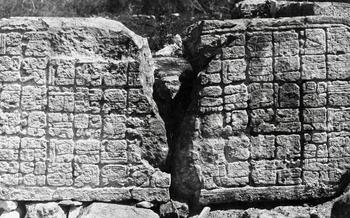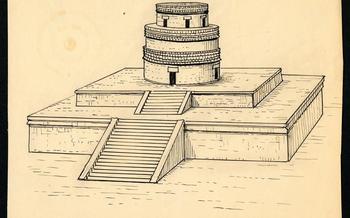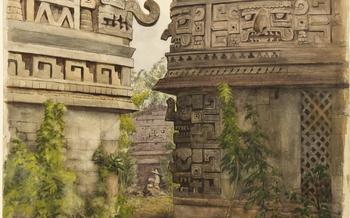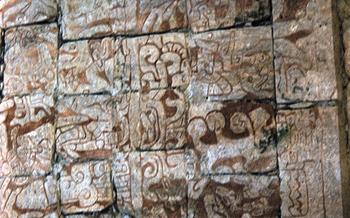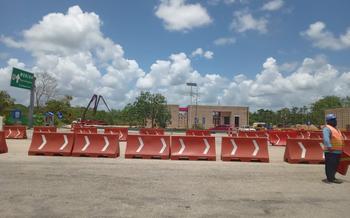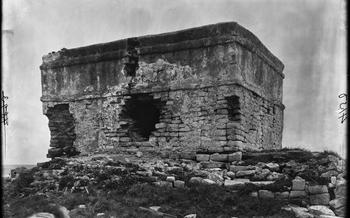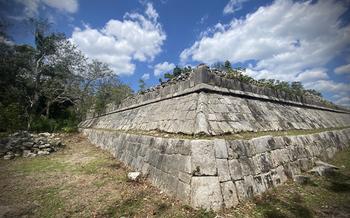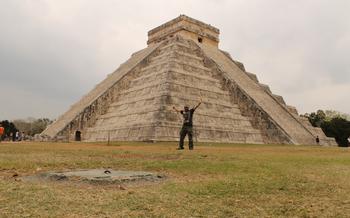
Cenote Calavera (Temple of Doom)
- A Journey to the Temple of Doom
- Unveiling the Secrets of the Temple
- Exploring the Cenote Calavera
- Stepping into the Underworld
- Diving into History
- Facing Your Fears
- Capturing the Moment
- Respecting the Sacred
- A Journey Through Time
- Local Delights
- Exploring Beyond the Temple
- A Memorable Souvenir
- Staying Safe and Informed
- Insider Tip
A Journey to the Temple of Doom
Chichen Itza, the ancient Mayan city in Mexico's Yucatán Peninsula, is home to the iconic Temple of Doom, also known as the Kukulcan Pyramid. This majestic stepped pyramid, with its grand staircase and intricate carvings, is a testament to the ingenuity and craftsmanship of the Maya. Built between the 8th and 12th centuries AD, the pyramid was a significant religious and ceremonial center for the Maya. It was dedicated to Kukulcan, the feathered serpent deity, and was believed to be a gateway to the underworld. The pyramid's alignment with the sun during the spring and fall equinoxes, when the setting sun casts a unique shadow on the pyramid, further adds to its mystical allure.
Planning your visit to the Temple of Doom is essential to make the most of your experience. The best time to visit is during the shoulder seasons (May-June and September-October) when the weather is pleasant and the crowds are smaller. Remember to wear comfortable shoes for climbing the pyramid and bring water, sunscreen, and a hat to protect yourself from the sun. Cameras are allowed, but flash photography is prohibited to preserve the site's integrity.
Unveiling the Secrets of the Temple
The Temple of Doom, also known as the Kukulcan Pyramid, stands as a testament to the architectural prowess and spiritual beliefs of the ancient Maya. Its grand staircase, adorned with intricate carvings depicting feathered serpents, leads visitors on a journey through time. The pyramid's alignment with the cardinal points and its astronomical significance are a testament to the Maya's advanced knowledge of mathematics and astronomy.
During the spring and fall equinoxes, the sun casts a unique shadow on the pyramid's northwestern staircase, creating the illusion of a serpent slithering down the steps. This phenomenon, known as the "descent of Kukulcan," is a captivating sight that draws visitors from around the world. Legends and myths surround the Temple of Doom, including the story of a vengeful High Priest who cursed the pyramid, leading to its abandonment.
Exploring the Cenote Calavera
Located just a short distance from the Temple of Doom, the Cenote Calavera, also known as the "Temple of Doom Cenote," is a natural wonder that holds both cultural and historical significance. This ancient sinkhole, formed by the collapse of a limestone bedrock, is approximately 20 meters in diameter and 15 meters deep, creating a breathtaking spectacle.
The Cenote Calavera holds a special place in Mayan culture. Cenotes were considered sacred portals to the underworld, or Xibalba, and were often used for rituals, offerings, and communication with the gods. The Mayans believed that cenotes were gateways to the realm of the dead, where the souls of the deceased could journey to the afterlife.
Stepping into the Underworld
Descend into the depths of the Cenote Calavera, either by carefully navigating the stone staircase or braving the rope ladder that leads directly into the water. As you enter this subterranean realm, a sense of awe and wonder envelops you. The atmosphere is eerie, almost sacred, with a palpable energy that whispers of ancient rituals and secrets.
The cenote's interior is a symphony of natural beauty. Gaze upon the mesmerizing rock formations that adorn the walls, each one a testament to the relentless work of water and time. Stalactites and stalagmites, like frozen waterfalls, hang precariously from the ceiling and rise from the depths, creating a surreal and otherworldly landscape.
Immerse yourself in the crystal-clear waters of the cenote, feeling the refreshing coolness envelop your body. The water's transparency allows you to observe the intricate details of the underwater world, from the delicate aquatic plants to the darting fish that call this hidden oasis home.
Swimming in the Cenote Calavera is an experience unlike any other. The water's buoyancy seems to defy gravity, allowing you to float effortlessly, surrounded by the cenote's ethereal beauty. As you glide through the water, a sense of tranquility washes over you, leaving you feeling refreshed, invigorated, and deeply connected to the natural world.
Diving into History
The Cenote Calavera has been the site of numerous archaeological discoveries, providing valuable insights into Mayan culture and beliefs. Excavations within the cenote have unearthed human remains, including skulls and bones, as well as artifacts such as pottery, jewelry, and tools. These discoveries suggest that the cenote was used for various purposes, including sacrificial rituals and offerings to the gods.
Theories abound regarding the cenote's significance in Mayan cosmology. Some believe it was a portal to the underworld, a place where the Maya communicated with their ancestors and deities. Others suggest that it was a source of water and sustenance, providing a lifeline during times of drought. The cenote's unique geological features, such as its depth and the presence of underwater caves, may have contributed to its sacred status.
Ongoing research and exploration within the Cenote Calavera continue to shed light on the complex and fascinating world of the ancient Maya. Archaeologists and researchers are working to decipher the secrets of this enigmatic site, uncovering new clues that help us better understand the beliefs, practices, and rituals of this remarkable civilization.
Facing Your Fears
Ascending the Temple of Doom and descending into the Cenote Calavera can be daunting for many. The fear of heights, commonly known as acrophobia, can make the climb up the pyramid a formidable challenge. On the other hand, claustrophobia, the fear of confined spaces, can trigger anxiety when entering the narrow confines of the cenote.
Yet, these experiences offer a unique opportunity for personal growth and self-discovery. Confronting these fears requires courage and resilience, leading to a profound sense of accomplishment. Overcoming these obstacles not only pushes personal boundaries but also builds self-confidence and resilience, leaving a lasting impact on individuals.
Embracing the challenge of facing one's fears can lead to a transformative experience. It fosters a sense of empowerment and encourages individuals to step outside their comfort zones, ultimately leading to personal growth and a newfound appreciation for the beauty and wonder of the world.
Capturing the Moment
When visiting the Temple of Doom and the Cenote Calavera, capturing the moment through photography is a natural instinct. The sheer majesty of these ancient structures and the ethereal beauty of the cenote demand to be immortalized. However, it's important to remember that these are sacred places, and respect for the site and its cultural significance should be paramount.
Respect the Sacred Space
Before you start snapping away, take a moment to consider the impact of your actions. Avoid using flash photography, as it can be disruptive to other visitors and damaging to the delicate structures. Instead, make use of natural light to capture the essence of the place.
Compose Your Shot
Take your time to compose your shot carefully. Look for interesting angles and perspectives that showcase the unique features of the pyramid and the cenote. Experiment with different focal lengths and apertures to achieve the desired depth of field and bokeh.
Capture the Essence
Beyond the technical aspects, strive to capture the essence of the place. Convey the awe-inspiring scale of the pyramid, the mysterious allure of the cenote, and the spiritual significance that permeates the air.
Share Your Experience
Once you've captured your shots, share your experience with others. Post your photos on social media, using relevant hashtags to connect with like-minded travelers and inspire them to embark on their own journey to this incredible destination.
Respecting the Sacred
In the realm of ancient wonders, it is imperative to approach the Temple of Doom and the Cenote Calavera with reverence and respect. The Maya civilization held these sites sacred, imbuing them with profound cultural and religious significance. As visitors, it is our responsibility to honor their legacy by adhering to certain guidelines and Verhaltensweisen.
Appropriate attire is a key aspect of showing respect. While the tropical climate may tempt you to dress scantily, it is advisable to opt for modest clothing that covers your shoulders and knees. This not only demonstrates cultural sensitivity but also aligns with the dress code enforced at the site.
Disruptive behavior is another pitfall to avoid. The tranquility of these sacred spaces should not be marred by excessive noise or unruly behavior. Refrain from shouting, playing loud music, or engaging in activities that may disturb other visitors or harm the environment.
The site authorities have implemented guidelines to ensure the preservation and protection of these ancient treasures. It is crucial to comply with these regulations, such as staying on designated paths, refraining from climbing on structures, and not littering. By following these rules, we contribute to the conservation of this irreplaceable heritage for future generations to appreciate.
By embracing these principles of respect, we not only enhance our own experience but also contribute to the preservation of a cultural legacy that has stood the test of time.
A Journey Through Time
Standing amidst the ruins of Chichen Itza, one can't help but feel a profound connection to the past. As you gaze upon the majestic Temple of Doom, envision the ancient Maya people who built this awe-inspiring structure. Imagine the rituals and ceremonies that took place here, the sacrifices offered to appease the gods, and the bustling activity of a once-thriving city.
The Temple of Doom and the Cenote Calavera are not just historical landmarks; they are portals into a bygone era. They offer a glimpse into the lives of the Maya, their beliefs, and their intricate civilization. By exploring these ancient wonders, we gain a deeper appreciation for the ingenuity, artistry, and resilience of this remarkable people.
As you climb the pyramid, feel the weight of history beneath your feet. Imagine the ancient Maya priests ascending these very steps, carrying offerings to the gods. When you reach the top, take a moment to soak in the breathtaking views, just as the Maya did centuries ago.
Descend into the Cenote Calavera, and let the darkness envelop you. Feel the cool, refreshing water on your skin, and listen to the echoes of the past reverberating within the cenote's depths. As you swim through its crystal-clear waters, imagine the Maya performing rituals and communicating with their gods in this sacred place.
A visit to the Temple of Doom and the Cenote Calavera is not just a sightseeing adventure; it is a journey through time, a chance to connect with the spirit of the ancient Maya and gain a deeper understanding of their rich cultural heritage.
Local Delights
In the heart of the Yucatan Peninsula, where the ancient Maya civilization flourished, a culinary journey awaits. As you explore the sacred sites of Chichen Itza, tantalize your taste buds with the region's delectable offerings. Indulge in the aromatic flavors of cochinita pibil, a traditional slow-cooked pork dish wrapped in banana leaves. Savor the crispy panuchos, tortillas filled with refried beans, shredded chicken, and pickled red onions. Refresh yourself with tropical fruits like sweet pineapples, juicy mangoes, and tangy oranges.
Venture beyond the tourist traps and seek out family-run restaurants and markets that serve authentic Yucatecan cuisine. Engage with the friendly locals and learn about the culinary traditions that have been passed down through generations. Support the local economy by purchasing ingredients and souvenirs from these small businesses, ensuring that the benefits of tourism are shared by the entire community.
As you savor each bite, imagine the ancient Maya who once inhabited this land. Picture them gathering around communal fires, sharing meals, and celebrating their rich culture. Allow the flavors of Yucatan to transport you back in time, creating a memorable culinary experience that complements your journey through the sacred sites of Chichen Itza.
Exploring Beyond the Temple
While the Temple of Doom and the Cenote Calavera are undoubtedly the highlights of Chichen Itza, the archaeological site offers a wealth of other attractions that are equally captivating. The Great Ball Court, located just a short walk from the Temple of Doom, is one of the largest and best-preserved ball courts in the Mayan world. Here, you can marvel at the intricate carvings depicting the game of pok-ta-pok, a ritual sport that held great significance for the Maya.
Another must-see is the Temple of the Warriors, which is adorned with impressive columns, intricate friezes, and a row of fearsome warrior statues. Take your time to explore the temple's various chambers and admire the well-preserved murals that provide glimpses into the lives of the ancient Maya.
If you're up for more cenote exploration, there are several other stunning cenotes located in the vicinity of Chichen Itza. Cenote Ik Kil, with its crystal-clear waters and lush vegetation, is a popular spot for swimming and diving. Cenote Azul, known for its deep blue waters and underwater caves, offers a more adventurous experience for experienced divers.
To make the most of your time in the region, consider venturing beyond Chichen Itza and exploring other Mayan ruins in the Yucatán Peninsula. Ek Balam, with its towering acropolis and well-preserved frescoes, is a hidden gem that offers a more intimate glimpse into Mayan culture. Coba, with its towering Nohoch Mul pyramid, the tallest in the region, is another must-visit for those seeking off-the-beaten-path experiences.
By creating a well-rounded itinerary that includes a visit to the Temple of Doom, the Cenote Calavera, and other attractions in the area, you'll gain a deeper understanding of the rich history and culture of the Maya.
A Memorable Souvenir
Visiting the Temple of Doom and the Cenote Calavera offers a unique opportunity to bring back a piece of Mayan culture and history. The local artisans in Chichen Itza showcase their skills and creativity through a variety of handcrafted souvenirs and goods. From intricate pottery and colorful textiles to hand-carved wooden figurines and traditional Mayan clothing, there's something for every taste and budget.
When shopping for souvenirs, it's important to support fair trade practices and ensure that the artisans are fairly compensated for their work. Look for cooperatives or shops that work directly with local communities and promote sustainable practices. Bargaining is a common practice in Mexico, but do so respectfully and be prepared to pay a fair price for the items you purchase.
Whether you choose a hand-woven hammock to relax in, a vibrant embroidered blouse to wear, or a decorative piece of pottery to display in your home, your souvenir will serve as a tangible reminder of your visit to this ancient and awe-inspiring site. Share the beauty of Mayan culture with friends and family back home, and inspire them to embark on their own journey to explore the wonders of Chichen Itza.
Staying Safe and Informed
When embarking on your adventure to the Temple of Doom and the Cenote Calavera, safety should be your top priority. The following guidelines will ensure a smooth and enjoyable experience:
-
Sun Protection: The Yucatan sun can be unforgiving, so slather on sunscreen with a high SPF and reapply throughout the day. Cover up with lightweight clothing, a hat, and sunglasses to protect your skin and eyes.
-
Hydration: The heat and humidity can quickly lead to dehydration, so bring plenty of water with you. Stay hydrated by sipping water regularly, especially during your climb up the pyramid and your swim in the cenote.
-
Terrain Awareness: Be mindful of the uneven terrain and slippery surfaces, especially around the pyramid and the cenote. Wear appropriate footwear with good traction to prevent slips and falls.
-
Wildlife Respect: The area is home to various wildlife, including iguanas, coatis, and bats. While these animals are generally harmless, it's important to maintain a respectful distance and avoid touching or feeding them.
-
Weather Preparedness: Before your visit, check the weather forecast and be prepared for sudden changes in weather conditions. The Yucatan region is prone to occasional rain showers, so carry a light raincoat or poncho just in case.
By following these safety guidelines and being aware of your surroundings, you can fully immerse yourself in the wonders of the Temple of Doom and the Cenote Calavera without compromising your well-being.
Insider Tip
For the most rewarding experience, plan your visit to the Temple of Doom and Cenote Calavera during the shoulder seasons, which fall between May and June, and September and October. During these periods, you'll encounter fewer crowds, allowing you to fully immerse yourself in the site's ancient wonders. Additionally, the weather tends to be more pleasant, with warm, sunny days and cooler nights, making your exploration more enjoyable. Embrace the tranquility of the off-season and create lasting memories in this awe-inspiring setting.
